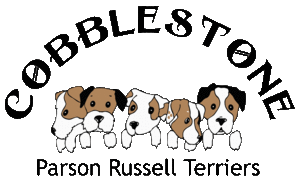BREED HISTORY
The Parson Russell Terrier was first bred in the south of England
in the mid-1800's to hunt European red fox, both over and under
the ground. The Parson Russell ran with horse and hound as the
hunt trailed the fox across the Devon countryside. When the
hounds drove a fox to ground the terrier followed, baying to bolt his
quarry so that the chase could continue.
Everything about the Parson Russell Terrier says foxhunting:
conformation, character, attitude and intelligence. He is of
balanced and flexible build with straight legs and a narrow chest.
He measures ideally between 12" and 14" in height. Coat is
broken, dense, straight, harsh and tight so as to give a smooth
appearance from a distance. His height gives him the length of leg
to follow the fox and hounds, and the narrow chest, flexible frame
and tenacity to follow a fox below ground. He is bold though
cautious in temperament, an independent, intelligent terrier
accustomed to working alone with only his instincts to guide him.
Indeed, many a tale has been told of a Parson Russell finding the
fox before the hounds could.
The Parson Russell is named for the most renowned of British
huntsmen, Rev. John Russell, "The Sporting Parson" (1795-1883),
whose passion for foxhunting, hounds and working terriers is
legendary. Rev. Russell and his compatriots bred with care uniform
terriers measuring 14" in height and 14-17 lbs. in weight. Rev.
Russell's own terriers were known to be of a distinct type: white or
predominantly white with tan or black and tan markings traditionally
confined to the head and base of tail.
Rev. Russell was a founding member of England's Kennel Club in
1873, and in 1874 he judged fox terriers for The Kennel Club. In
his day, Rev. Russell was called "The Father of the Wirehaired Fox
Terrier", at a time when it was thought that wire coats were a
passing fad. Rev. Russell's bloodlines are found in the pedigrees
of early smooth fox terriers, for as a breeder of broken coats he
often bred to smooth-coated fox terriers to improve coat quality.
His bloodlines are also found on both sides of the wire-coated
bitch, L'il Foiler, dam of the well known wire champion, Carlisle
Tack, said to be indistinguishable from the type terrier bred by
Parson Russell.
Foxhunting in the southern part of Great Britain was, and is today,
comprised primarily of mounted hunts riding over the fields of the
countryside. Terriers working these hunts were required to be
baying terriers. Parson Russell demanded that his terriers be
"steady from riot", for the hunt ended if the fox did not bolt. In the
south, "hard" Russells who tried to kill the fox underground were
suspected of carrying undesirable bull terrier blood (hence the
brindle disqualification in the standard). In the northwest of England
near the Scottish border, foxhunts are not mounted and man and
dog follow the fox on foot over rocky terrain. Northern terriers are
often expected to be hard dogs who can latch onto their quarry
and drag it from the earth as the rocks make it difficult to dig. In
the north, hard Russell-type terriers were suspected of carrying
Lakeland or fell terrier blood (hence the faulting in the standard of
a curly or kinky coat).
The Parson Russell Terrier was, and should remain, a baying
terrier whose job is to bolt, not kill, his quarry. This part of the
breed's history affects both its correct type and attitude in the
show ring today.
After Rev. Russell's death, the name "Jack Russell Terrier" was
misused to describe all mix and manner of working and hunt
terriers, many of which bore little, if any, similarity to Rev. Russell's
own terriers. The mounted style of foxhunting in southern England
had been hampered by expanding agricultural practices and the
sport became expensive. Those without sufficient land or resource
took to fox and badger digging for terrier sport. Terriers were
carried to known settes and released down an earth to attack
whatever they found, no horses or hounds required. These terriers
were more aggressive than intelligent, and needed not the leg,
stamina nor common sense of the early Parson Russell. The public
came to know a "Jack Russell" only as a game working terrier,
regardless of shape or size. Unfortunately, it was this kind of
terrier: long-backed, short-legged, prick-eared, frequently
achrondroplastic and of questionable temperament, that was
imported to America incorrectly bearing the name "Jack Russell
Terrier". Rev. Russell and his compatriots would never have
recognized these terriers as the Parson Russell or the Fox Terrier,
for indeed they are not.
The first breed Standard was drafted in 1904 by Arthur
Heinemann, who founded the Parson Jack Russell Terrier Club in
1914. The standard called for a 14" terrier and accurately reflects
the original Parson-type terrier. This type terrier was kept alive by
sportsmen in southern England and recorded through the years by
well-known dog fanciers.
In England in the early 1970's, a 10" to 15" height standard was
devised to encompass the myriad of commonly popular post-war
breed distortions. The 10" to 15" standard calls for a "balanced"
terrier as does the 12" to 14" standard. From a breeder's
standpoint, the 10" to 15" standard is impossible to reproduce as a
10" balanced terrier has none of the bone, substance, or stature
necessary to satisfy breed function.
(This Breed History was borrowed from the PRTAA as an educational tool.
Please note the PRTAA reserves its copyright on this educational information)

